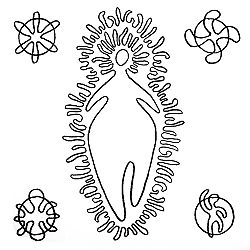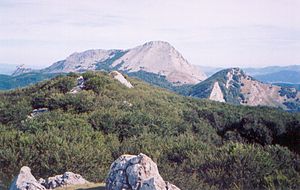- Mari (goddess)
-
For the Indian goddess called "Mari", see Mariamman.
Mari, Mari Urraca, Anbotoko Mari ("the lady of Anboto") and the possibly distinct Murumendiko Dama ("lady of Murumendi") was a goddess — a lamia — of the Basques. She was married to the god Sugaar (also known as Sugoi or Majue). Legends connect her to the weather: that when she and Majue travelled together hail would fall, that her departures from her cave would be accompanied by storms or droughts, that which cave she lived in at different times would determine dry or wet weather: wet when she was in Anboto, dry when she was elsewhere (the details vary). Other places with where she was said to dwell include the chasm of Murumendi, the cave of Gurutzegorri (Ataun), Aizkorri and Aralar, although it is not always possible to be certain which Basque legends should be considered to pertain to the same lamia.
Contents
Etymology
There is much confusion over the origin of the name Mari. For some it is just the transposition of the Christian name of the mother of Jesus, Mary, but others prefer to believe that it is a modification of Emari (gift) or Amari (mother + the suffix of profession) by losing the first vowel. The closeness in names may have helped turn the Pagan worship of the goddess Mari into a Christian veneration of the Virgin Mary.[1] The first known written citation of the Dame of Amboto was made by Charles V's chronicler Esteban de Garibay Zamalloa in his Memorial histórico español.[2]
Beliefs associated with Mari
Mari lives underground, normally in a cave in a high mountain, where she and her consort Sugaar meet every Friday (the night of the Akelarre or witch-meeting) to conceive then the storms that will bring fertility (and sometimes disgrace) to the land and the people. Mari is served by a court of sorginak (witches), and is said to feed on the negation and affirmation (that is on falsehood).
Occasionally the figure of Mari is linked to the kidnapping or theft of cows, but the presence of Christian priests in those myths may indicate that they are actually Christian fabrications or distortions. In fact it doesn't seem that any kind of sacrifices were offered, at least normally, to Mari, in contrast to what happened with lesser spirits (lamiak, jentilak, etc.), who were given food as payment for their work in the fields.
In various legends Mari is said to have sons or daughters, but their number and character fluctuates. Maybe the most famous were her two sons, Atxular and Mikelatz. Atxular represents largely the Christianized Basque soul, becoming a priest after having learned from the Devil himself in a church in Salamanca and then having escaped. Mikelatz instead seems to have a more negative or wild character and is sometimes assimilated into the spirit of storms, Hodei or embodied as young red bull.
Another legend presents Mari as wife to the Lord of Biscay, Diego López de Haro. This marriage may symbolize the legitimacy of the dynasty, much in the style of the Irish goddess marrying the kings of that island as a religious act of legitimacy. In any case, the condition that Mari imposes to her husband is that, while he could keep his Christian faith, he was obliged to keep it outside the home. Nevertheless, once, apparently after discovering that his wife had a goat leg instead of a normal human foot, he couldn't avoid making the sign of the cross. Immediately after that sacrilegious act, Mari took her daughter, jumped through the window and disappeared, never to ever come back. This outcome can obviously be seen as delegitimizing the de Haro family, who, after all, had been placed as lords by the Castilian conquerors not long before.
Other legends are much simpler. For example, there is a legend that when one is lost in the wild, one only has to cry her name loudly three times to have her to appear over one's head and so find the right way.
The belief in Oñate was that the weather would be wet when she was in Anboto, dry when she was in Aloña. In Zeanuri, Biscay, they say that she would stay seven years in Anboto, then the next seven in a cave in Oiz called Supelegor. A similar legend in Olaeta, Biscay substitutes Gorbea for Supelegor.
Another legend from Otxandio, Biscay has it that she was born in Lazkao, Gipuzkoa, and that she was the evil sister of a Roman Catholic priest. In other legends, the priest is her cousin Juanito Chistu, rather than a brother, and is a great hunter. She was said to take a distaff by the middle and walk along spinning, and leaving storms in her wake.
In Elorrieta, Biscay, it was said that she would be in her cave, combing her hair, and not even a shepherd could draw near to her. It was also said that her malign power did not extend to those who were innocent of sin.
Folklorist Resurrección María de Azkue ties Mari Urraca to a legend about a princess of the Kingdom of Navarre, widow of a 12th-century nobleman who lived in the Tower of Muncharaz in the valley known as the Merindad de Durango. She vanished at the time of his death and was said to have headed for the cave of Anboto. According to Azkue, Iturriza tells this story in his Historia de Vizcaya; Labayru in her Historia de Vizcaya doubts it.
Legends attached to the Lady of Murumendi, according to Azkue, include that she had seven brothers and was changed into a witch for her disobedience, that the weather would be warm (or that it would be turbulent) when she walked about. In Beizama, Gipuzkoa, they say that if she stays in her cave and if on the day of the Holy Cross appropriate spells are cast, hail can be prevented. They also say that she and her husband once went to church in a cart and that upon leaving church she rose into the air saying "Domingo, Domingo el de Murua, siete hijos para el mundo, ninguno para el cielo" ("Domingo, Domingo of Murua, seven children for the world, none for the sky").
Mari was associated with various forces of nature, including thunder and wind. As the personification of the Earth her worship may have been associated with that of Lurbira. Mari's consort was Maju; their children included the benign spirit Atarrabi and the evil spirit Mikelats.
Mari was regarded as the protectoress of senators and the executive branch. She is depicted as riding through the sky in a chariot pulled by horses or rams. Her idols usually feature a full moon behind her head.
Mari is the main character of Basque mythology, having, unlike other creatures that share the same spiritual environment, a god-like nature. Mari is often witnessed as a woman dressed in red. She is also seen as woman of fire, woman-tree and as thunderbolt. Additionally she is identified with red animals (cow, ram, horse) and with the black he-goat.
Christianization
According to some anthropologists, Santa Marina, a saint revered in the Basque Country, is in actuality a Christianized version of Mari. Basque women still invoke Santa Marina's protection against curses and for aid in childbirth. [1]
Nevertheless the most accepted synchretism is that with Virgin Mary, which is widely venerated by modern Christian Basques.
See also
References
- ^ This derives from articles in the Enciclopedia General Ilustrada del Pais Vasco Encyclopedia Auñamendi, which in turn cite Euskalerriaren Yakintza, Tomo I "Costumbres y supersticiones", by folklorist Resurrección María de Azkue (1864-1951) and also mentions that further legends are recorded by Jose Miguel Barandiaran and Juan Thalamas Labandibar.
- ^ Esteban de Garibay Zamalloa, Memorial histórico español: colección de documentos, opúsculos y antigüedades, Tomo VII.
External links
Categories:- Basque and Iberian deities
- Basque mythology
- Sky and weather goddesses
Wikimedia Foundation. 2010.


